Introduction
Learning a foreign language is an important resource for the communication at
any field. The use of English as a way to share ideas, give opinions and
interchange information is an important defense for the students in their
personal and professional lives.
However, the acquisition of a new language includes the development of the four
skills Writing, Listening, Speaking and Reading (Cohen, 2014; Herrell &
Jordan, 2015) but not all the time all these skills are developed equally and at
the same time so that it is necessary to reinforce and make emphasis to the one
that it is not well developed. It is therefore important to establish an
effective strategy for ex diagnosis before beginning a teaching-educational and
research project (Barroso, Calero & Sánchez, 2015; Barroso, Sánchez,
Calero, Recalde, Montero & Delgado, 2015).
Generally speaking is one of the most effective skills on English Language’s
teaching. This skill is a preferred resource now of teaching any foreign
language also in the educational system.
While the use of an appropriate vocabulary could be a great problem for the
students when they want to perform an educational activity and even on the
practice of the English Language and it is the principal factor of this research
(Huang, Huang, Huang & Lin, 2012; Carter & McCarthy, 2014; Elizabeth,
Barahona, del Rocío & Manzano, 2016), the main purpose as to find a
solution to this problematic and the proposal was created by a deep study of the
students’ need.
The topic of this thesis is “Influence of the Acquisition of Vocabulary in
Oral expressions” as a support resource for English Teaching to learners. This
study has as a main objective to improve the communicative activities of
students from eighth General Basic Year from “Dr. Luis Felipe Borja Pérez”
High School, through the survey could be gotten direct results from deficiencies
in the English language based on their own contexts of this level.
Nowadays, the development of the language in English had been an important
factor for the world and is necessary that the students of the country could
obtain a good level of vocabulary especially in their oral expression (Alsagoff,
McKay, Hu & Renandya, 2012; Orwell, 2013; Pennycook, 2014).This problem was
set in the Eighth General Basic Year, at “Dr. Luis Felipe Borja Pérez” High
School, which is located in a poor area of the city. They receive a poor level
of English and they do not have the enough practice for having an intermediate
level in oral expression, is for that reason that this subject could be
difficult for their comprehension because they do not understand the native
expressions. This project is on a methodological design based on a field,
bibliographic and statistics research
Therefore, the students cannot express their ideas in a clear way; they cannot
take dictation, write words, identify the correct grammar rules and learn new
vocabulary in the English language.
The necessity of didactic resources is a problem because the students do not
have an adequate material for learning words, which are used in a daily way. All
these factors produce a necessity of interest to the students now of learning a
new language.
Objective
To examine the influence of the acquisition of vocabulary in oral expression,
through a bibliographic study, analyze field, in order to design a didactic
guide for the benefit of students of eighth general basic year at “Dr. Luis
Felipe Borja Pérez” High School.
Development
The aim of this project was to investigate the development of the four skills in
English in the public institutions, where several difficulties were found in the
“Dr. Luis Felipe Borja Perez” High School, this institution has as a mission
that graduates have to become into leaders in the transformation of technical
education, through innovative programs and research skills of high quality that
promote the community development in the scientific and technical knowledge,
sequentially acquired and practiced according to the requirements of the
productive sector and as a vision in this institution is to train young people
with quality and warmth, able to adapt to the requirements of today's world,
liveries and lovers of democracy, prepared for life and leadership capable of
providing solutions that contribute to the development of the society, applying
values in all areas, that operate with positive attitude, critical
thinking, reflective opinions and creativity.
“Dr. Luis Felipe Borja Pérez” High School is located in “La Prosperina”
Cooperative, under the supervision of Lcda. Violeta Ávila A. MSc., who is the
principal of the Institution and the responsible of the progress of the school
consequently she is always thinking on the best programs accordance to the
requirements of the development of the education around the country and the
world, this study was focused specially of the students of Eighth General Basic
Year of the institution.
During the Teaching Practice was noticed the necessity of vocabulary on the oral
expression of the students in the classroom at the moment of expressing the
students’ idea, is for that reason that this investigation was carried out to
find a solution to this problem and propose a useful material where could be
possible the development of the lexical in teenagers between 12 and 15 years
old, the objective through this proposal is to find a solution to the lexical
development of the teenagers and to obtain the best results on that field.
Some of the factors that influenced the difficulty to develop the oral
communication in English were:
-
Necessity
of didactic resources in vocabulary field.
-
Absence
of oral expression in class activities.
-
Incomprehension
of vocabulary in context.
The aim was to examine the influence of the acquisition of vocabulary skills to
speak, through a literature review, analysis and field, to design a guide. The
specific objective is to define the influence of the acquisition of vocabulary
skills to speak, through a study. Analyze the development of oral expression
through studies, analysis, student surveys and interviews with experts.
According to Meara (1980): "the learners have mentioned that foreign
language vocabulary acquisition as the main source of trouble learning the
language." (p. 221). It means that learners consider learning vocabulary is
the principal trouble in learning process.
Furthermore, within the study of vocabulary learning strategies follows the
classification of Levin and Pressley (1985):
-
Repeat
strategy does not pose any degree of preparation by the apprentice. They
consist simply of thinking, speaking aloud or write the same word several
times in order to memorize it.
-
Sensory
strategies are based on the idea that the vocabulary better retained if
processed through different channels and motoric sensory experiences.
-
Semantic
strategies are based on the semantic processing of new vocabulary; in
its analysis and recognition of the "natural" associations, you
have with the rest of the lexicon, and in enhancing these relations to
improve memorization.
-
Mnemonic
strategies are the establishment of relations "artificial",
partnerships created on purpose in order to improve memorization. In
accordance with Cohen (1987) defined that: "the value of mnemonics is
that makes the student perform an analysis of the word mental activity to
create images or" scenarios "contributes to the formation of
connections that improve memory.” (p. 45)
The learning of new words is influenced by several factors such as the frequency
of occurrence of the word, care provided, prior knowledge and the order they
appear, so that by learning the vocabulary there is a process ranging from
aspects and nuances a term as indicated Laufer (1998) mentioned: “We realize
that progress in vocabulary learning is not only a quantitative issue. Knowledge
of words may progress from superficial too deep at various stages of learning”.
(p. 255). Laufer sustains that vocabulary resources produce an immense develops
in education system.
Likewise, Pérez (1999) from the point of view psycholinguistic said
"vocabulary acquisition involves three different processes: input, storage
and retrieval." (p. 265)
-
Input:
The words are retained in short-term memory, depending on the depth to which
the entry is processed, this happens in circumstances of attention and then
goes to storage.
-
Storage:
It is that information is stored in semantic fields, and elements are
organized by associating phonological similarities: structure, accent,
sounds and images with words to achieve retention.
-
Recovery:
After the above processes, the words are searched and retrieved quickly.
Setting these processes, Pérez shows three primordial systems for working in
vocabulary section related to the attention of the learners using terms and
phonological aspects.
-
There
different Types of Vocabulary which are classified according to the
frequency of its application.
-
Usual
vocabulary: The set of terms that are used on the street or in a daily life’s
speaking, it consists in the common words used by any English native
speaker. It is composed of 12,913 words, which are necessary in basic
education.
-
Common
vocabulary: Those words make up the usual vocabulary, it is normally used in
almost all the aspect of life, and it could be used in family environment,
cultural or even social aspects. This vocabulary consists of 1,971 words.
This kind of vocabulary is the most used from the educational tasks.
-
Fundamental
Vocabulary: This type does not contain any problem, is composed of 210 words
with a frequency that can be understood in different and special
atmospheres.
Classification
of Vocabulary
-
Size:
This refers to this period as "amplitude" when speaking vocabulary
size, and the number of words that learners can learn. Probably the
vocabulary size is the only dimension that matter in small vocabularies.
-
Depth:
This refers to the knowledge that the student has reached. It is also
considered that the size is more relevant than the depth, because the
extensive vocabulary is crucial for the student, as there are hard data that
the size of the vocabulary.
-
Receptive
(passive): These are also called passive, when a speaker is interpreted
in different situations that receive messages.
-
Productive
(active): Also called active, are the set of units of the mental
lexicon, where a speaker actually used in the messages sent.
These four strategies set important pedagogical resources for learning a foreign
language using the learners’ retentive. As a result, they help a better oral
expression by learners.
This investigation project will allow putting forward
a proposal of improvement to develop the skill of speaking that it’s
relevant for the communication in the English language. It is
appropriated since the context in which the students and teachers
are unrolled in this project.
The oral expression serves as a communication tool between pupils where teachers
must generate less encourage communicating with the acquisition of new
vocabulary, this means that through the vocabulary learners can prove their
communicative expressions in their environment. According to Aguilera Quinto
Edith (2012) in her thesis "Expression and Comprehension on Language and
its Incidence on Learning" (p. 21-22) has quoted to Douglas Barnes (2007),
Language Strategies in Learning, said about: “Talking is the main medium
through which students explore the relationship between what they already know
and the new observations and interpretations of the reality faced. In fact each
of us talking to himself to explain our thoughts.” (p. 17). In this quote, the
writer sustains that oral expression is the best way to the students for making
up their ideas through oral expression and the observations and interpretations
are intrinsic and subjective depending of the thoughts from the teenagers.
Moreover, the role that has performed the oral language in accordance with
Antich (1986) said. "The primacy of spoken language lies in the objective
reality of nature as a social phenomenon and through verbal communication par
excellence Hence the need to give priority to the establishment of mechanisms
for listening and speaking, which means that first presented oral language and
written language is taught from what learners have learned orally. " (p.
64). Antich states that speaking language is the principal tool for the verbal
communication and for learning any language. In addition, expressing orally is
one of the best means for teaching a language.
Otherwise, the mission of the teacher is to use the vocabulary as a key factor
to strengthen the oral expression, to increase the knowledge not only to learn
the meaning of each word but associate in order to have greater variability and
security in a conversation. According to Monica Torres (2010), who in her book
Basic Methodology for Teaching English, said: “When a new Word is found in
learning English, it is very important to work out its meaning and then to store
it in a written form in some way, so that the learner can remember and find it
again as necessary”. (p. 14). Torres in her study gave a value message about
vocabulary use and affirms that obtaining new vocabulary is the principal factor
in the oral expression and it implicates search for the meaning of each word
learned that is a priority in an oral expression.
The investigation was based on Epistemological, Psychological, Pedagogical and
Legal Foundations.
The necessity of didactic resources is a problem because the students do not
have an adequate material for learning words which are used in a daily way. All
these factors produce a necessity of interest to the students at the moment of
learning a new language.
According to Ferrer (1994) related "Communicating is to share something
between ourselves, that is, is a specific radical and emotional quality of man
that arises from the need to contact others, when exchanges ideas that acquire
significance or meaning according to common prior experiences”. (p. 25). It
expresses that the communication is the only way to share ideas between the
learners and it is a basic factor developing the learning process in any class.
Consequently, communication in English is an element that needs to be developed,
because of emphasizes the oral expression; because it is the set of techniques
that determine the guidelines for communicate orally effectively and without
barriers.
In the same way, oral expression is based on the communication already that
provides foundation for developing other skills for the study of language, this
means that develop the ability to speak what others are saying, and for her
part, Antich (1986) stated:
A long time ago, this foundation has been applied in the teaching-learning
process by showing that the context in where it unwraps the learners, it makes
emphasize the scientific facts involving the growth of cognitive development of
learners to more effectively build their knowledge, this means that the new
contents are combined with prior knowledge schemes organized logically to be
applied in a certain reality.
Besides this the psychologically learning has two essential learning approaches
that claim depends on the development, social, intellectual and emotional
evolution that is the way it organizes the environment, according to several
authors such as Piaget, Bandura and Ausubel say about approaches construction of
knowledge.
Meanwhile, Cesar Solórzano (2007) in his book "Constructivism: Learning
Base Durable" cited Piaget's thinking:
Learning isn’t a spontaneous demonstration of isolated forms, but an
indivisible activity comprised of the processes of assimilation and
accommodation, the resulting balance allows the person actively adapt to the
reality, which is the ultimate goal of learning where knowledge is acquired
not only by internalizing the social environment, but dominated the
construction made by the subject. It is a process in which new information is
incorporated into existing structures or patterns in the minds of people,
amending and reorganized as a mechanism of assimilation and accommodation
provided by the student activity. The development of intelligence is an
adaptation of the person to the world or surrounding environment, is developed
through the process of maturation, a process that also includes learning
directly. (p. 64)
In this quote mentioned by Piaget it is sustained that learning is an important
component in the assimilation and accommodation progress and it is an important
factor on the adaptation to the reality. Piaget sustains that learning is the
only way for developing human criteria and intelligence, which are natural,
processes in people’s life.
As a result, pedagogy arises from the necessity of train learners under a
constructivist paradigm to be more socio-cognitive and analytical to be part of
the social innovation within the education system.
Methodological
design
This Project has a methodological development in both aspects quantitative and
qualitative. The qualitative is expressed in the process of scientific
understanding it moved through the logic of research from the theoretical
support of the variables studied, until the interpretative processes, and the
quantitative data obtained from tabulations of the survey and interviews.
Theoretical
methods
-
Analysis-Synthesis:
These methods were used to focus the object of study based on the two
variables exposed before being analyzed step by step with the objective of
evaluate them in an integral way. This method also travels throughout the
logic of research.
-
Inductive-Deductive:
It allows the investigation to begin with the particular fact unique in a
given context to conclude with a scientific generalization.
-
Historical
and Logical: This methodology was applied after an intense research and the
analysis of the background of the Institution and its necessities through a
specific theoretical frame as assistants of this investigation.
-
Structural-Systematic:
In this investigation was applied a structural design because it is divided
into two punctual chapters for the study of the problem and the application
of a solution through the construction of a Didactic guide for the use of
the teacher and the students.
Empirical
Methods
-
Observation:
to detect and assimilate the information found in the selected context for a
record of certain facts through a physical document as the observation
guide.
-
Survey:
To obtain useful data a special bank of questions was designed and applied
through close questions in order to know the students’ previous
experiences inside English classes
-
Interview:
It was an important resource to obtain the authority and teacher’s
opinion, experience in class and their vision of this project.
Statistical
methods
-
Mathematical-Statistical
Analysis: This method helps to collect statistical information, which can be
observed in tables and graphs that allowed highlighting the difficulties and
strengths found in each evaluated criteria,
-
Chic
Square: It was applied to prove the relation between the two variables
studied.
-
The
purpose of this investigation is to find the reality of the education, that
is why different investigation instruments as Surveys, Interviews and Direct
Observation were applied and their results will be explained in the
following paragraphs..
-
The
analysis of the survey showed that students have a low level in the oral
expression in English. This deficiency is caused by the insufficient
application of vocabulary activities. In addition, the students admit and
agree that the implementation of activities in classes will reinforce their
development in fluency. It showed that students are afraid of talking in
classes, and the classes are often boring and not interesting.
-
In
addition, in the interview to the teacher, he accepted that the use of a
Didactic Guide could be a great tool for developing oral expression due to
the fact of the insufficient vocabulary from the students.
-
In
the survey, the students agreed that it is very important having a Didactic
Guide for the use of English specially at the moment of talking in English
Language because it is not their mother tongue and their consider that
having a good vocabulary knowledge is an important characteristic for
speaking in English
-
In
the observation guide, it was clear that the teacher does not use a Didactic
Guide to develop a speaking activity, as a consequence the students did not
feel ensure to speak.
-
Finally,
the teacher was glad to be part of this investigation; and said that she
would like to have a copy of the activities that this project will present
Results
Due to the English language is the second language worldwide and is important in
all areas as social, economic, commercial, educational, etc., it was designed a
proposal methodological strategies that encourage students to acquire vocabulary
for improving the oral expression of the students.
This proposal was designed to strengthen the learning of oral expression,
academic achievement and personal to each student through vocabulary, so it
wants to get positive results in students and that teacher can properly use the
strategies in each development class, undoubtedly trying to contribute with this
new idea to increase the knowledge of students.
The proposal has become a viable alternative means and solution, so this project
proposes the application of a methodological guide with strategies in order to
improve the quality of student learning, and thus ensures social welfare,
coexistence peaceful and the development of skills of the beneficiaries. It also
promotes an integral and cooperative development.
Conclusions
The students agreed that it is very important to have a Didactic Guide for the
use of English especially at the moment of Speaking, because it is not their
mother tongue and they consider that having a good knowledge in vocabulary is an
important characteristic for speaking in English.
Conforming the Chi square results, a big part of the students agreed that
obtaining a better didactical resource to practice their vocabulary accuracy
could increase their oral expression as one of the most important skills in any
language.
In the observation guide, it was clear that the teacher does not use a Didactic
Guide to develop speaking activities; consequently, the students were not
confident to speak.
In the interview to the teacher, he accepted that the use of a Didactic Guide
could be a great tool for developing the oral expression due to the fact of the
insufficient vocabulary from the students.
The application of a didactic guide with vocabulary banks and common expressions
for teenagers will develop one of the most important skills in the process of
learning English in the students of Eighth Basic Course at “Dr. Luis Felipe
Borja Pérez” High School.
Acknowledgements
The research Project: Gestión de competencias para publicaciones científicas
en estudiantes de pregrado y postgrado de la Universidad de las Fuerzas Armadas
ESPE.
Bibliography
-
Aguilera,
E. (2012). Expression and Comprehension on Language and its Incidence on
Learning (Fifth edition). London: Routledge.
-
Alsagoff,
L., McKay, S. L., Hu, G. & Renandya, W. A. (Eds.). (2012). Principles
and practices for teaching English as an international language. London:
Routledge.
-
Antich,
R., Grandales, D. & López, E. (1986). Metodología de la Enseñanza
de Lenguas Extranjeras. D. G. Antich & E. López ( Trans.). La
Habana, Cuba: Editorial Pueblo y Educación.
-
Barnes,
D. (2007). Language Strategies in Learning. London: Routledge &
Kegan Paul.
-
Barroso, G., Calero, S. y Sánchez, B. (2015). Evaluación Ex
ante de proyectos: Gestión integrada de organizaciones de Actividad Física y
Deporte. Quito, Ecuador. Editorial de la Universidad de las Fuerzas Armadas
ESPE.
http://repositorio.espe.edu.ec/bitstream/21000/10166/3/Evaluci%C3%B3n%20exante%20de%20proyectos%20de%20gesti%C3%B3n.pdf
-
Barroso, G., Sánchez, B. Calero, S., Recalde, A., Montero, R. y
Delgado, M. (2015). Evaluación exante de proyectos para la gestión integrada
de la I+D+i. Experiencia en universidades del deporte de Cuba y Ecuador. Lecturas:
Educación Física y Deportes. Buenos Aires, Año 20, Nº 204 http://www.efdeportes.com/efd204/evaluacion-de-proyectos-en-universidades-del-deporte.htm
-
Carter,
R. & McCarthy, M. (2014). Vocabulary and language teaching.
London: Routledge.
-
Cohen,
A. D. (1987). The use of verbal and imagery mnemonics in second-language
vocabulary learning. Studies in second language acquisition, 9(01),
43-61.
-
Cohen,
A. D. (2014). Strategies in learning and using a second language.
London: Routledge.
-
Elizabeth,
J., Barahona, G., del Rocío, I. & Manzano, M. (2016). The use of
word sets, synonyms-antonyms, definition and illustrative sentences as
methodological techniques to teach vocabulary of english language with the
students of primer año de bachillerato paralelo “F” at unidad educativa
fiscal “Capitan Edmundo Chiriboga" during the academic year 2014-2015
(Bachelor's thesis, Riobamba, UNACH 2016).
-
Ferrer,
A. (1994). Comunicación Oral. México: Pearson Educación.
-
Herrell,
A. L. & Jordan, M. L. (2015). 50 strategies for teaching English
language learners. Madrid: Pearson.
-
Huang,
Y. M., Huang, Y. M., Huang, S. H. & Lin, Y. T. (2012). A ubiquitous
English vocabulary learning system: Evidence of active/passive attitudes vs.
usefulness/ease-of-use. Computers & Education, 58(1), 273-282.
-
Laufer, B. (1998). The development of passive and active
vocabulary in a second language: Same or different? © Oxford University
Press. Retrieved from
http://www.tpdl.ac.nz/site/tpdl/files/Resources%20%20documents/General/Vocab%20learning/laufer-1998.pdf
-
Levin,
J. R. & Pressley, M. (1985). Mnemonic vocabulary instruction: what's
fact, what's fiction? In R. F. Dillon & R. R. Schmeck, Individual
Differences in Cognition. New York: Academic Press.
-
Meara,
P. (1980). Vocabulary acquisition: A neglected aspect of language learning.
Language Teaching, 13(3-4), 221-246.
-
Orwell,
G. (2013). Politics and the English language. London: Penguin UK.
-
Pennycook,
A. (2014). The cultural politics of English as an international language.
London: Routledge.
-
Pérez
Basanta, C. (1999). La Enseñanza del Vocabulario desde una Perspectiva
Lingüística y Pedagógica. In S. Salaberri (Ed.). Lingüística
Aplicada para Segundas Lenguas (pp. 265-306). Almería: Universidad de
Almería.
-
Solorzano,
C. (2007). Constructivism: Learning Base Durable. USA.
-
Torres,
M. (2010). Basic Methodology for Teaching English. Classroom
Management (2nd ed.). Riobamba: Rio Impressions.
Annexed
Welcome
Section:
|
Objective |
preparation
procedure |
Practice |
|
Unit
1: Social strategy |
|
•To
identify the new meaning of the words
•To
get students to have the ability to use new vocabulary in real situations.
•To
reinforce vocabulary learned as it becomes a fact experiential.
|
Motivation:
Hangman
Presentation:
•Students
will review the vocabulary of parts of the house. |
Practice:
•Correct
use of the vocabulary of the parts of the house in real situations.
•Active
development concerning doing chores at home. |
Production:
•Students
identify new words.
•
Do a debate. |
|
Unit
2: cognitive strategy |
|
•
To identify the meaning of vocabulary words through the strategy of grouping
words.
|
Motivation:
MIMIC
GAME
Presentation:
•
Write a great number of words in different categories in a box to show students. |
Practice:
•The
student must locate each of the words according to the relevant category.
|
Production:
•
Guessing the actions being undertaken using the vocabulary learned using the
words in the box.
|
|
Unit
3: alphabet soup strategy |
|
•
To develop oral communication by introducing into sentences the prepositions
of place. |
Motivation:
Ask
students to be fixed around, objects and their partners.
Presentation:
•Look
at the pictures and label them with the correct preposition |
Practice:
•
Tell the students locate the pictures according to the prepositions of place. |
Production:
•
Students know and learn about the prepositions. In addition, they will be able
to structure and not just to say sentences.
|
Unit
1. Social strategy
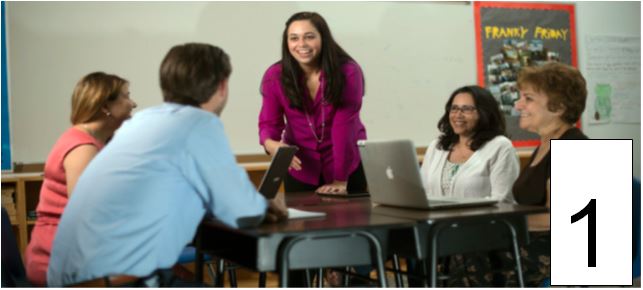
Objective
of the class
-
To
identify the new meaning of the words.
-
To
get students to have the ability to use new vocabulary in real situations.
-
To
reinforce vocabulary learned as it becomes a fact experiential.
Motivation:
5 min
Hangman
1.
Put on the board a picture of a man with a rope.
2.
Put on the board counting how many horizontal lines
3.
Letters is the word that students try to guess.
4.
Ask letters to students, if the letters do not match choking man go,
students have five opportunities.

5.
Students identify the meaning of new words that are within a given frame;
with this strategy, they can put graphics in the right way. Living room
dining room bedroom kitchen Bathroom laundry studio.
6.
Have students guess what word is hidden in this game by selecting one by one
the letters that compose it. If you select the letter is in the word, it
will appear in their proper place; if not, and a part of the picture of a
hangman appears. If the figure hangman is completed before the word, you
discover an error accumulates; if you can discover the whole word before
this happens, you accumulate a success.

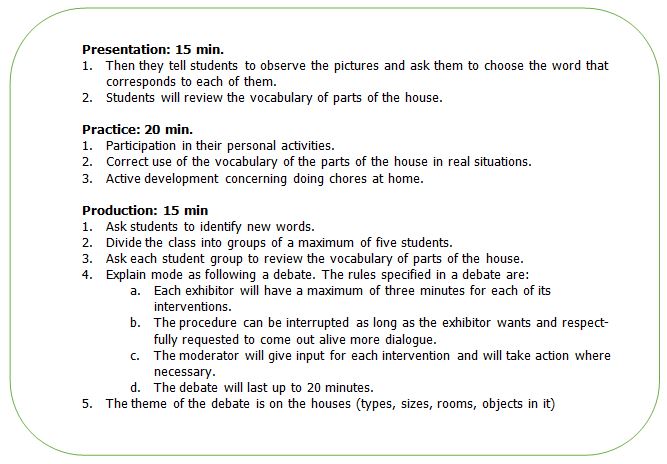
Assessment
1
Name:____________________________
Grade____________________________
Date:____________________________
Point:
1.
Label the picture
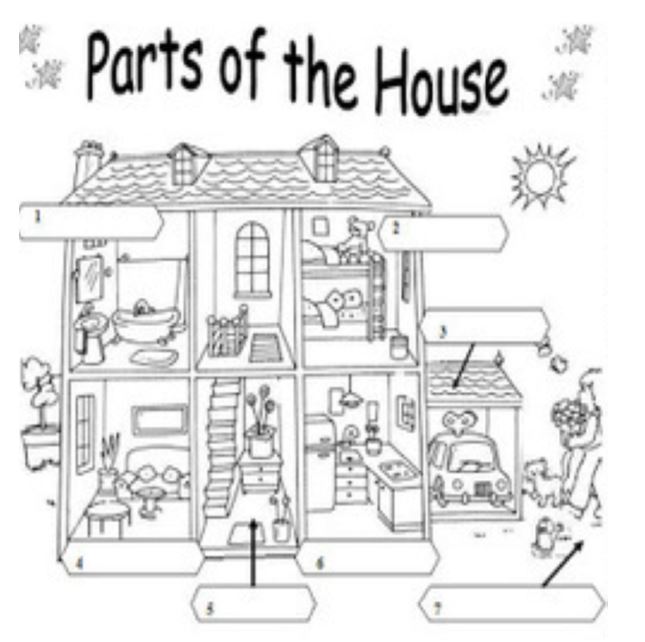
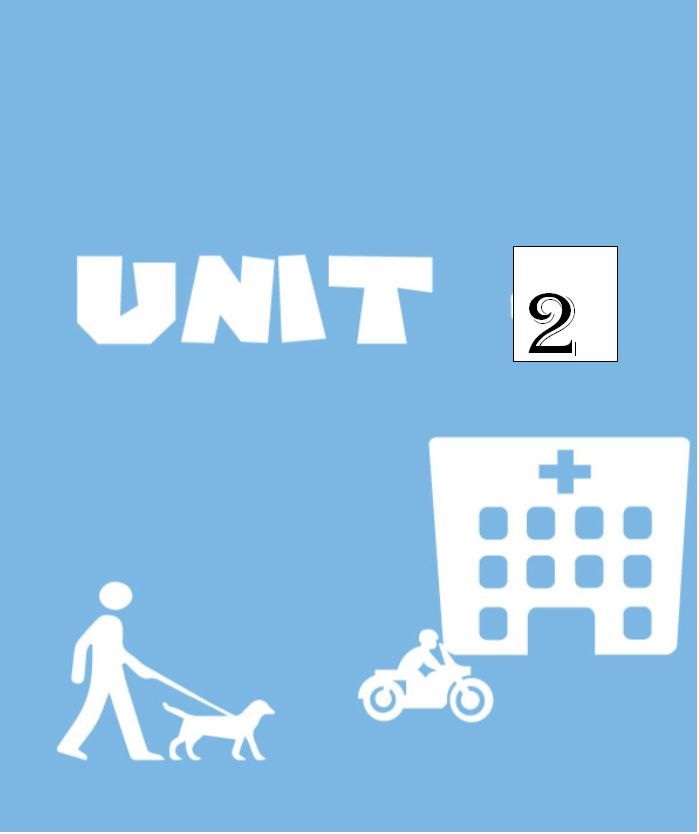
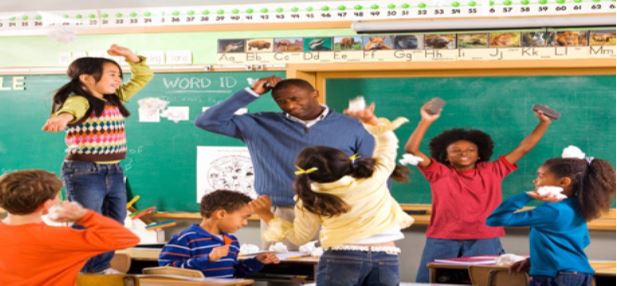
Objective
of the class
Motivation:
5 min.
Mimic
Game
-
Explain
the activity: guess the actions the student using the vocabulary is
performing.
-
This
is the classic game of mimic, which not only allows pamper the actions
represented on the charts, but also train the oral expression (for example:
to guess the action, describing it), working vocabulary of actions and
verbs.
-
The
drawings must show different categories: animals, musical instruments,
transport, objects of daily life, clothing and activities and professions.
-
Just
print, cut and laminate the pictures, whose status is determined by a color.
You can also make a die and place it on each side of the corresponding
category, so each player to roll the dice know what type of category will
play.
-
You
can also make a die and place it on each side of the corresponding category,
so each player to roll the dice know what type of category will play.

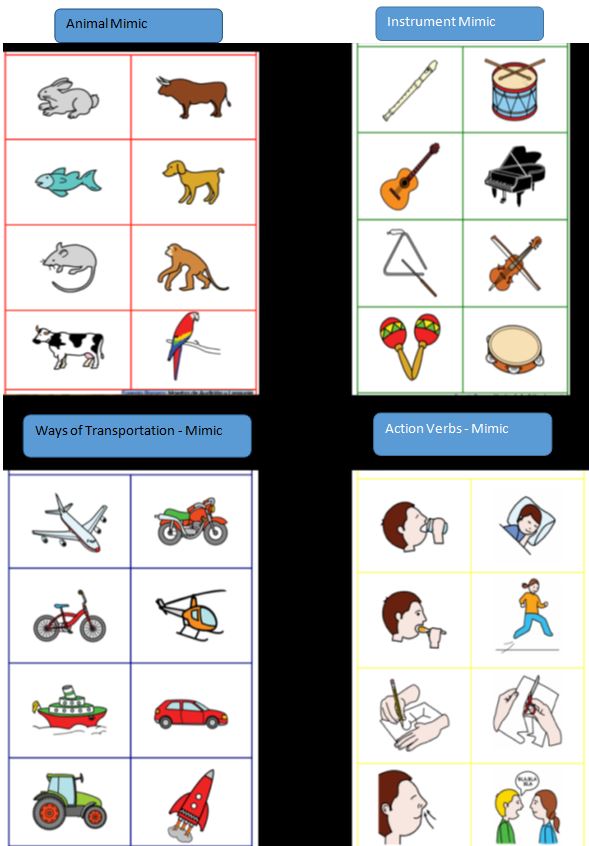
Presentation:
10 min.
1.
Write a great number of words in different categories in a box to show students.
Review
the pronunciation with the students.

Production:
15 min.
Task 1
-
The
student must locate each of the words according to the relevant category.
-
The
student becomes familiar with the new vocabulary that ranked in their
categories.
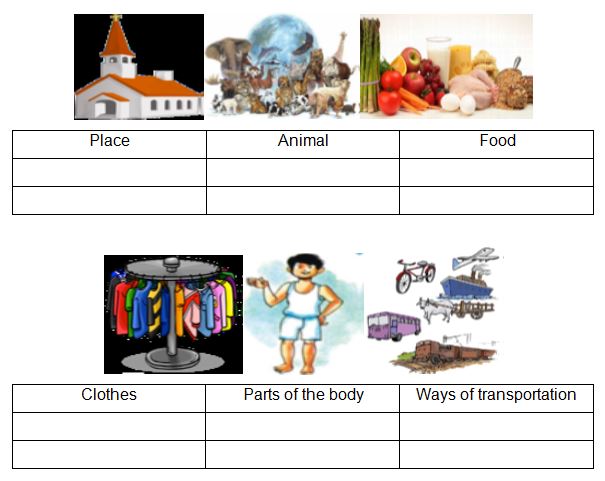
Task 2
-
Guessing
the actions being undertaken using the vocabulary learned using the words in
the box.
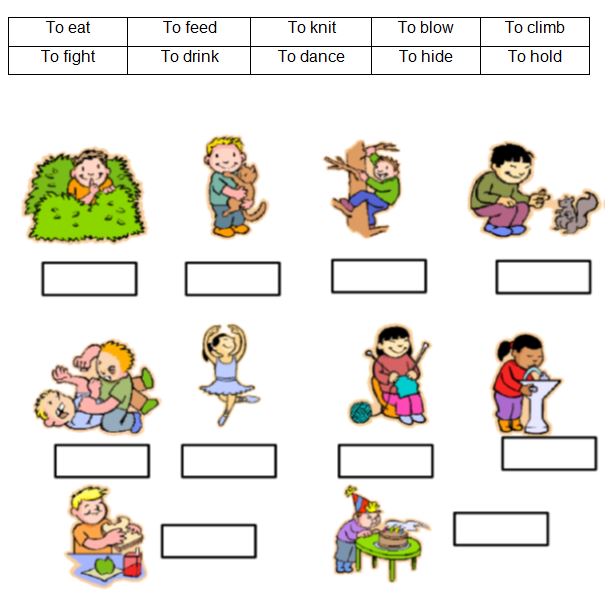
Evaluation:
5 min.
Assessment
2
Name:____________________________
Grade____________________________
Point:
Date:____________________________
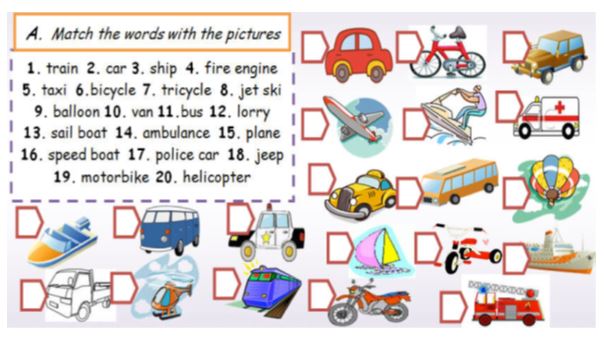
B.
Match the pictures
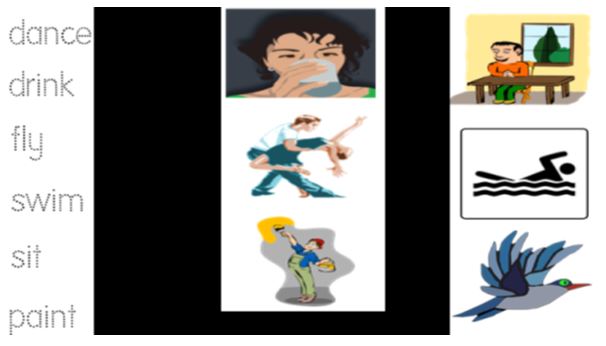
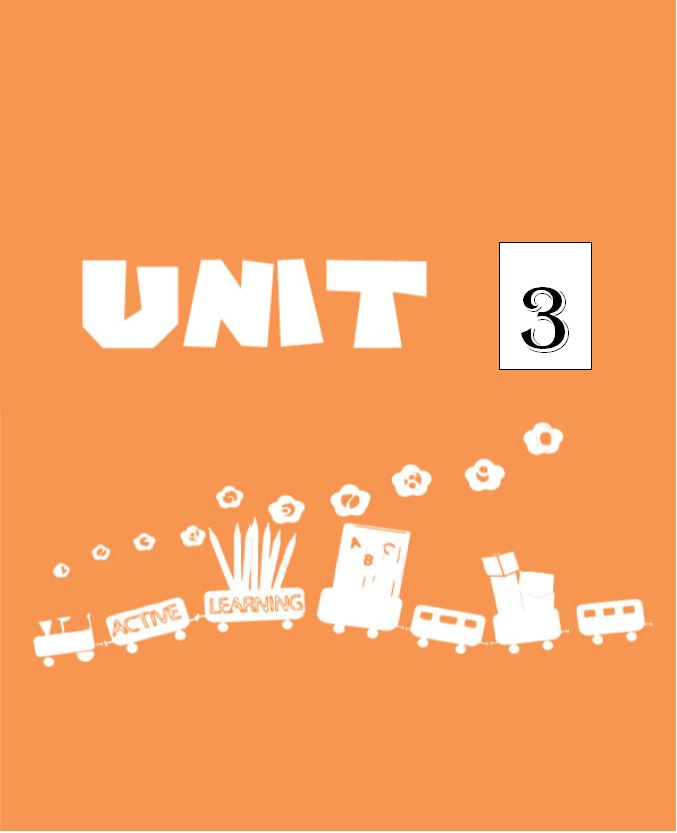
Alphabet
soup strategy

Objective
of the class
Motivation:
5 min.
Explain
the activity
-
Ask
students to be fixed around, objects and their partners. Then by means of a
known example of the prepositions of place, you must show at least three
prepositions.
-
Later,
motivates a student to do the same as you, saying the position of a nearby
companion or subject to a limit of 5 minutes using the three prepositions of
place and provide help if necessary.
-
After
this you can enter the other prepositions of place.
Presentation:
5 min.
Task 1
Task 2
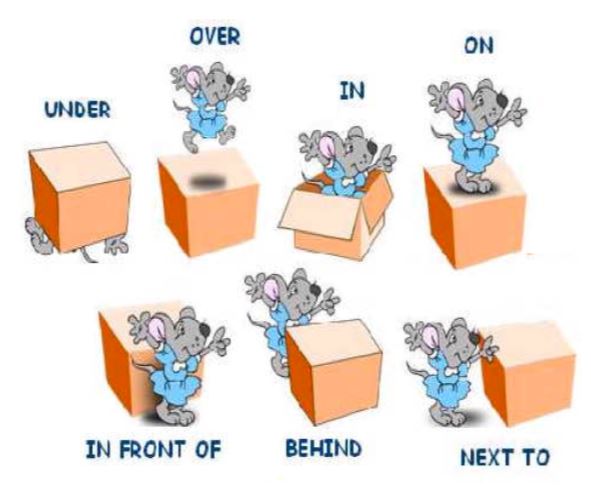
Practice:
10 min.
Task 1

Production:
15 min.
-
Students
know and learn about the prepositions of place. In addition, they will be able
to structure and not just to say sentences but to write sentences.
-
Looking
at the charts, they will be able to describe each of them, using prepositions
of place and practice with peers
Evaluation:
5 min.
-
Students
practice using the prepositions of place real classroom objects.
-
Students
use prepositions of place in short paragraphs and include the vocabulary
-
Perform
a short description using prepositions
Assessment
3
Name:____________________________
Grade____________________________
Date:____________________________
Point:
Complete
the sentences with the prepositions of places using the words in the box
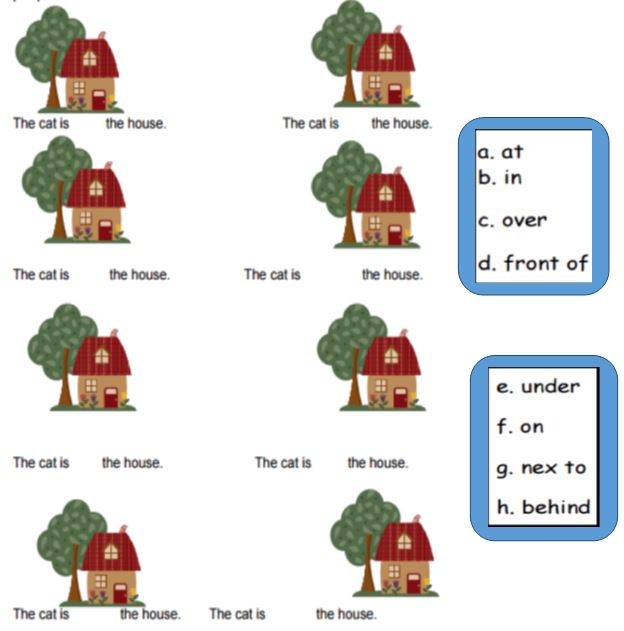
Another articles in English

|
|
|
EFDeportes.com, Revista
Digital · Año 21 · N° 221 | Buenos Aires,
Octubre de 2016
Lecturas: Educación Física y Deportes - ISSN 1514-3465 - © 1997-2016 Derechos reservados
|



















